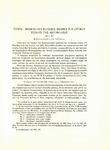Τίρυνς: Μυκηναϊκή επίχωσις έξωθεν του δυτικού τείχους της ακροπόλεως

Προβολή/
Συγγραφέας
Βερδελής, Ν.Ημερομηνία
1966Γλώσσα
el
Εκδότης
Υπηρεσία Αρχαιοτήτων και Αναστηλώσεως
Λέξη-κλειδί
Βιβλιογραφικά στοιχεία
Αρχαιολογικόν Δελτίον, 1965, Τόμος 20, Μελέται/Μέρος Α', 137-152.
Πρόσβαση
ελεύθερη
Τίτλος περιοδικού
Αρχαιολογικόν Δελτίον
Επιτομή
During the restoration of the West Wall at Tiryns in 1957 a deposit of Mycenaean
pottery of unique importance was discovered. It consisted of a large quantity
of pottery from a domestic context, in four strata belonging to a single period
Late Helladic IIIB 2. This can be used as the basic evidence for identifying the
pottery of this period. The painted pottery forms the subject of this report. The
unpainted pottery has not yet been studied.
Deep Bowls make up 65% of the total painted pottery. Two main
groups can be distinguished. Group A ( PI. 1 - 2 ) have only fine linear decoration
inside and outside and a simple uncrowded pattern zone ( Open Style ).
Group B ( PI. 3 ) have heavy bands of paint outside, monochrome paint inside
and a more crowded pattern zone ( Filled Style ). The decorative tendencies of
these groups are discussed in detail and are given also in tabular form. It may be
noted that the proportion of deep bowls of Group B increased from 4.5 to 13%
from the earliest to the latest of the four strata.
Stemmed Bowls ( 10% - PI. 4 ) and K r a t e r s ( 3% - PI. 6 ), are
considered to be related in their system of decoration to deep bowls but to show
certain distinct differences.
The other open shapes include a type of S h a 11 o w Bowl ( PI. 6, 2, 3)
previously thought rare on the greek mainland. This shape frequently has designs
in added white on the bands of paint inside the bowl. A variety of other small
Bowls ( PI. 6, 4. 5) as well as Mugs are represented. Handmade Bowls
and Jugs ( PI. 6,6. 7) make up 3.5% of the total pottery.
The commonest closed shape is a J u g or A m p h 0 r a ( 10% - PI. 6, i )
decorated with linear bands only. Other closed shapes represented are Stirrup
Jars ( 5% - PI. 5, 2. 3), Piriform Jars and patterned Jugs ( PI. 5, 4 ).
The stirrup jars are of the small globular type and have both a patterned shoulder
and a patterned body zone.
In conclusion it is considered that this pottery agrees well with that already
known but because of its quantity, suitable for statistical analysis, it offers vital
new evidence of the range of shapes and the details of design.


